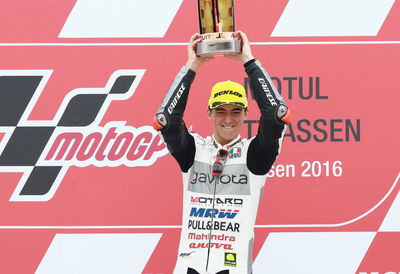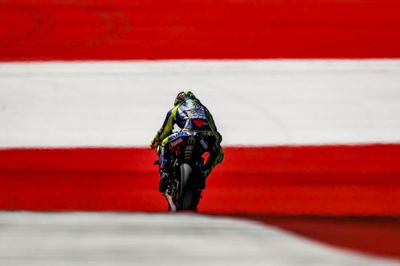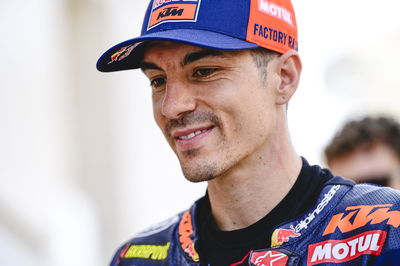What's next for race winner Mahindra?

Mahindra Racing CEO Mufaddal Choonia sat down with a handful of media for what proved to be a lengthy and good humoured chat over breakfast at the German MotoGP.
Choonia had every reason to be happy; Mahindra - which joined the world championship in 2011 - had just become the first Indian manufacturer to claim a grand prix victory, courtesy of Francesco Bagnaia in the Moto3 class at Assen.
"It's been an historic win for us," Choonia began. "All those who follow motorsports in India have gone crazy and the Automotive journalists are really excited.
"What made this win really special is that this is not just the first time an Indian company has won in a premium racing motorcycle event - it is the first time ever that an Indian company has won any motorsport event at world championship level.
"Be it Formula One, off-road, truck racing, whatever. No Indian company has ever won a motorsport event at this level."
 |
| Choonia (left) celebrates Bagnaia's Assen victory (pic: Gold&Goose). |
"To be very fair to the management of my company, I don't think I've ever had a shortage of resources," Choonia replied. "I've never asked for 'x' amount of money and been told 20% less, or asked for 25 people to design a bike and been told '15'.
"So I don't think there will be any change in the resource allocation because I've always got I wanted. Let's be frank; in racing there are no half-measures. You are either in it or not. If you are in it, you have to do whatever it takes to win or it's better to stay at home. Our company understands that."
Mahindra competes against Honda and KTM in the Moto3 class and is facing a similar contest against world-leading brands in its enormous home market.
"15 million people buy two wheelers in India every year," Choonia said. "Mahindra makes about 10-11,000 bike and scooters a month.
"India is a market which is largely under 250cc. Of course there are some 300, 500, 1000cc bikes, but it's a very small percentage. 250-300cc is the area where we are really focussing on as a manufacturer, so Moto3 is the best category for us in that sense.
"The Indian two-wheel industry has changed a lot over the last four or five years. There has been an influx of foreign brands and because of that the customer is now completely aware of the technology available overseas.
"The consumer now expects that technology from Indian brands. This is where Moto3 really helps. We want to build the aura of strong technology around the Mahindra brand.
"There is a very close working relationship between the Mahindra two-wheel R&D team and Mahindra race team, for certain future products. So there is a clear technology transfer."
 |
| The 2011 Indian F1 Grand Prix. |
In addition to the huge motorcycle market in India, the 2,000,000 Facebook likes for Mahindra Racing suggests there would be plenty of local support for an Indian Grand Prix.
"I will be the happiest person on earth the day we have a home race," Choonia admitted. "We are really looking forward to the day when we can race in front of our home fans.
"When we won in India my office got a call on Monday from somebody from the sports ministry in India, who said: 'where is Mr Mufaddal Choonia, we want to take him to the Olympics in Rio as part of the Indian contingent!'
"My office was a little surprised, 'there is no motorcycle racing in the Olympics!' They said 'no, no, but [the win] is a great thing'.
"My office asked for his contact details because I was still travelling back from Assen, and he said, 'no, I'll call back'. I haven't heard anything, so I think he's either forgotten or he's already in Rio!
"I'm just so happy that somebody in the ministry is watching MotoGP!"
With races already held in SE Asia and South America, India is a notable absence from the MotoGP calendar.
The country already has a suitable track, the Buddh International Circuit, but F1 gave up after three seasons and Dorna has so far not been able to reach a suitable agreement for MotoGP or World Superbike.
"Whenever I have discussed it with Dorna they are very interested in coming to India. No question about it," Choonia said. "They have visited several times and have had meetings with the owners of the Buddh International Circuit, which is the only circuit that could host MotoGP.
"But there are two things that I believe need to be overcome. The first is the commercial aspects, which again Dorna has to work with. I believe that was one of the reasons why World Superbike didn't happen. The other thing is the government [customs] regulations around bringing material from outside the country and back out again."
If the difficulties could be overcome, Choonia is certain there is a huge audience waiting to welcome the sport.
"15 million people buy two wheelers in India every year so I'd be very worried if even 10% decided to come! We'd have a serious problem managing all the people!" he smiled.
"I think there is no question about the audience. 94,000 attended the first F1 race and F1 is still considered to be very expensive, elite, so you can imagine how many people would come for a motorcycle race.
"However India is also a very different market and has to be addressed that way. So, for example, if you keep the ticket price at 30-40 euros, I don't think anybody would come. 30 euros may not be very expensive here, but 30 euros is almost 4,500 rupees.
"For 4,500 rupees I could have a fantastic dinner with my wife in a 5-star hotel and probably some desert after! It's a lot of money in India. Ticket prices for a cricket match, which is entertainment for the full day, start at about 15 euros
"In India you have the power of numbers, so if it's priced right I think a MotoGP race would be phenomenal. When I'm driving on the road I see so many bikes which have 46 stickers, so if Rossi comes to India I'm sure 10% of those 15 million would come to see him.
"The races are already shown live on TV in India. It goes to about 250,000 households, so about 1 million people. It's not a free-to-air channel. It's a slightly expensive pay channel. So it goes to an elite household let's say. Of which there are a few million in India.
"But the channel which has it, Ten Sports, packages it quite well. There's a pre-show and all that. I've just been informed by my office in India that they are going to replay the entire Assen race before qualifying here."
 |
It is hard to know which is harder to achieve at the moment; a grand prix in India or an Indian grand prix rider.
"Of course, I'll be very happy the moment we find an Indian rider who can compete with the best talent in the world. But I think we are too far away as a country at the moment," Choonia admitted.
"First, motorcycle racing is very expensive as we all know and riders have to support themselves in the early part of their careers. I don't think there are many people in India who can afford that and those that could tend to go towards F1 or car racing.
"Also, motorcycle racing to Indian mothers is still a very dangerous sport to have their sons involved in. My mother thinks what I do is too dangerous, so you can imagine if I were to even send her a picture of me sitting on a bike!"
But given the skills needed to navigate the infamous road traffic in places like Mumbai, it's surely only a matter of time before an Indian rider makes it to the top: "The problem is there are only 30-35 riders on the grid. If there were 2-3,000 it'd be Indian riders finishing 1st-2nd-3rd. Guaranteed!" Choonia quipped.
On a serious note, Mahindra is exploring the possibility of setting up a one-make championship to help home grown riders.
"Immediately there are no such plans, but we have definitely been discussing something with the Mahindra two-wheel division. Simply because if there is a Mahindra Cup or something it must be based on a production machine, not a Moto3 machine, which would be too expensive for India" Choonia said.
"Even if we make a production variant of the Moto3 it would be too expensive. Also there is only one circuit that could take these Moto3 bikes, in Delhi.
"However what Honda, Yamaha and other companies do is have production based series. We currently don't have a sports bike in our production portfolio. Our so called high end, defined for the Indian market, is the Mahindra Mojo but it is more of a sports tourer."
 |
Turning to technical matters, Mahindra introduced a new gearbox design for the Sachsenring, in response to troubles with the original transmission.
"Firstly, there were times when the riders complained about missing gears," Choonia said. "The second issue we had - it happened very rarely, but it did happen - was that one or two riders complained that the gearbox went into neutral sometimes. Particularly John [McPhee] complained about that."
Choonia explained that the gearbox issues were actually the result of major changes to the engine.
"We've been using this gearbox for the last two years and never had these problems," he said. "But the bike is practically new this year. We have a new engine, which includes certain modifications to the crankcase, including the input shaft to the gearbox.
"Engine updates are not allowed during the season and everybody has finite resources, so we said, 'let's do everything it takes to get the engine done first, because we won't be able to modify it during the season, and if there is anything needed in the gearbox we will come out with an upgrade in the course of the year because that is allowed'.
"We took the decision to build the new gearbox after Qatar. We are working with an English company called Nova, who specialise in racing transmissions. They have helped us significantly in the design and manufacturer it.
"It's hard to measure [the performance gain] because it's different for different riders. What happens is this gearbox gives the rider an opportunity to really focus on the riding. Because the gearbox now is extremely precise and slick. So that itself makes the rider go faster.
"Pecco [Bagnaia] was one of the least effected riders by the problems with the old gearbox. He has been very comfortable with the bike and we are very lucky to have a rider whose riding style suits the bike brilliantly. [Jorge] Martin was the most effected by the gearbox and we saw he has gone forward immediately with the new gearbox."
 |
| Choonia with Jorge Martinez 'Aspar' (pic: Gold&Goose). |
Mahindra closed its own grand prix team several years ago in favour of a partnership with Aspar. Why?
"We had our own team until 2014, but I believe this is a far more successful model for us simply because there is a certain skillset which is required to run a team which we are manufactures don't have," Choonia said. "One of the most critical aspects of a team is communication with the riders.
"I believe there are certain individuals who can ran the race team this job much better than us. They've been very successful running teams because they have been riders themselves, or have been in this business for many years. Jorge [Aspar] being one of them.
"I think he is doing a very good job for us so I don't see any reason why we should be changing this model. It is very effective model and again has the best balance in terms of resource allocation and knowledge.
"Just as a team will never be able to design and build a complete bike as effectively as we can, we will not be able to run a team as effectively as they can."
But while Mahindra sought a partner to run its race team, the company has taken back an increasing amount of control over the design and manufacturer of its MGP30 racer from Suter.
"Suter is a supplier of parts to us. That is the only relationship we have with them. We buy certain parts because they have very good machining facilities," Choonia said. "So parts [of the new engine] were built by Suter, but the design was completely Mahindra Racing."
Two of this year's Mahindras have been branded as Peugeot machines: "At the moment is purely a branding and marketing relationship. As KTM did with Husqvarna. Peugeot is largely a scooter company. I'm not privy to their business strategy going ahead."
 |
| Bagnaia leads at Assen (pic: Gold&Goose). |
While the 600cc Moto2 category uses standard Honda engines, Moto3 maintains open engine and chassis competition, albeit under strict rules aimed at controlling costs and limiting the difference in machine specification for riders of the same brand.
"If you ask a manufacturer they will never be happy with the regulations and cost especially, because all of us lose money. Let's be frank. And not just small money. We lose big money on every engine we make, every bike we supply. But we of course take that as a development cost, marketing cost etc," Choonia said.
"If I were to look at it dispassionately, it's extremely difficult to have a balance between cost, regulation and at the same time ensure the health of the championship. I think the balance is quite good at the moment. But I don't know what's going to happen in the future.
"I like the idea of keeping regulations fixed for two-three years. It gives us a chance to really plan for the future. I remember when we had just joined and there were regulations changes every year. 125 to Moto3, then 14,000rpm to 13,500. These are big changes. So I'm very glad that we've decided to avoid any more major changes for now."
 |
| Start of the Dutch MotoGP race (pic: Gold&Goose). |
Mahindra currently supplies machinery to nine Moto3 riders, but Bagnaia (4th) is the only one of them in the top 20 of the world championship standings.
What are Mahindra's plans in terms of team numbers for next year?
"To be frank, I want teams that will give us results. Unlike in India where numbers matter, we are not a company that gets purely excited by numbers!" Choonia said. "It gives me no pleasure to supply 15 bikes if 12 of them are at the bottom of the table. I'm happy to supply any teams - so long as they are at the top."
Looking even further ahead, might Mahindra one-day line-up with its own prototype on the MotoGP grid?
"Not in the immediate future. Honestly first we have to make a success out of Moto3 before we think about another category," Choonia replied.
"We've been getting hurdles out of the way. When we started people said 'you should be consistently in the top ten'. Then it was top five. Then the podium. Then on the podium consistently. Then the management started saying, 'now I think we should win a race'. And we've done that.
"Now everyone is saying we should win the championship, so that is the next thing. Once that happens I can risk my job and start talking MotoGP to them!"
If the premier-class project did happen, it would probably be alongside both Moto3 and Moto2.
"If we were to decide to go to MotoGP someday, I think we would need to be in Moto2 also, so we could straddle all three classes and give our riders a career," he said. "Or at least be in partnership with teams like Aspar that has a presence in all three categories.
"It is one of the reasons why we feel it does not make sense to run our own team again. There were many riders who were not willing to join us because we couldn't give the rider a career.
"They would say, 'ok I'll come to you for Moto3 but then what next? I'd much rather join Alzamora, Ajo who can give me a career'. One of the strong reasons why we partnered with Aspar is because they get a career here."
Mahindra will be back in action during this weekend's Austrian Grand Prix at the Red Bull Ring.












